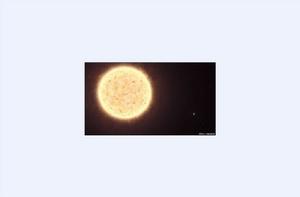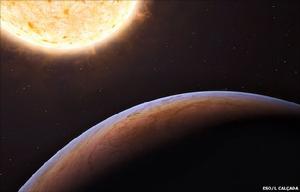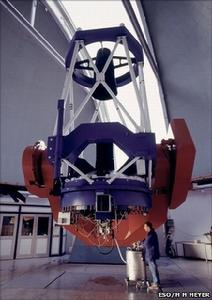'Alien'planetdetectedcirclingdyingstar
 This artist's impression shows HIP 13044 b, an exoplanet orbiting a star that entered the Milky Way from another galaxy
This artist's impression shows HIP 13044 b, an exoplanet orbiting a star that entered the Milky Way from another galaxy科技日報劉霞:據英國《每日電訊報》11月18日報導,德國科學家在最新一期的《科學快訊》雜誌上指出,他們在一顆起源於銀河系外的恆星附近發現了一顆新行星,這意味著該行星本身來自銀河系之外。這是人們首次發現起源於銀河系之外的行星,這一發現可能會使我們目前對行星的形成和留存的理解提出質疑。
迄今為止,科學家已經在銀河系內發現了大約500顆行星,但這顆新發現的行星是首顆源於銀河系外的行星,科學家將其命名為HIP13044b,它主要由氫氣和氦氣組成,重量是地球的400多倍。
該行星所繞轉的恆星儘管現在位於銀河系內,但其卻是起源於銀河系外。科學家表示,該恆星是希勒米星系的一部分,最初屬於一個矮星系,但在大約60億年到90億年前,該矮星系被銀河系“吞食”。
由於這顆行星距離地球大約2000光年,歐洲南方天文台(ESO)的天文學家們使用直徑2.2米的望遠鏡無法明顯地探測到它。
不過,其輕微的晃動泄露出了其存在,這些晃動由其所環繞的巨大恆星的引力拉動所造成。
德國馬普天文所的雷納·克萊門表示:“這個發現令人非常興奮。這是天文學家們首次在一個源於銀河系外的恆星附近探測到一顆行星。因為距離遙遠,迄今為止,我們還沒有探測到類似的行星。”
這顆行星環繞的恆星的生命已經快走到盡頭,其氫燃料幾乎快要耗盡,並且它已經經歷了恆星演化中的紅巨星時期,也就是當像太陽這樣的恆星已經擴大到其原先大小許多倍之巨的時候,在這個時期,它可能會消耗掉其內部的行星。現在,該恆星正在不斷收縮並且燃燒其內部的氦氣。
原文:
'Alien'planetdetectedcirclingdyingstar
Astronomersclaimtohavediscoveredthefirstplanetoriginatingfromoutsideourgalaxy.
TheJupiter-likeplanet,theysay,ispartofasolarsystemwhichoncebelongedtoadwarfgalaxy.
Thisdwarfgalaxywasinturndevouredbyourowngalaxy,theMilkyWay,accordingtoateamwritingintheacademicjournalScience.
Thestar,calledHIP13044,isnearingtheendofitslifeandis2000lightyearsfromEarth.
ThediscoverywasmadeusingatelescopeinChile.
Cosmiccannibalism
Planethuntershavesofarnettednearly500so-called"exoplanets"outsideourSolarSystemusingvariousastronomicaltechniques.
Butallofthosesofardiscovered,saytheresearchers,areindigenoustoourowngalaxy,theMilkyWay.
Thisfindisdifferent,theysay,becausetheplanetcirclesasunwhichbelongstoagroupofstarscalledthe"Helmistream"whichareknowntohaveoncebelongedtoaseparatedwarfgalaxy.
ThisgalaxywasgobbledupbytheMilkyWaybetweensixandninebillionyearsagoinanactofintergalacticcannibalism.
Thenewplanetisthoughttohaveaminimummass1.25timesthatofJupiterandcirclesincloseproximitytoitsparentstar,withanorbitlastingjust16.2days.
 This artist's impression shows HIP 13044 b, an exoplanet orbiting a star that entered the Milky Way from another galaxy
This artist's impression shows HIP 13044 b, an exoplanet orbiting a star that entered the Milky Way from another galaxyItsitsinthesouthernconstellationofFornax.
Theplanetwouldhavebeenformedintheearlyeraofitssolarsystem,beforetheworldwasincorporatedintoourowngalaxy,saytheresearchers.
"Thisdiscoveryisveryexciting,"saidRainerKlementoftheMaxPlanckInstituteforAstronomyinHeidelberg,Germany,whotargettedthestarsinthestudy.
"Forthefirsttime,astronomershavedetectedaplanetarysysteminastellarstreamofextragalacticorigin.Thiscosmicmergerhasbroughtanextragalacticplanetwithinourreach."
DrRobertMasseyoftheUK'sRoyalAstronomicalSocietysaidthepaperprovidedthefirst"hardevidence"ofaplanetofextragalacticorigin.
"There'severyreasontobelievethatplanetsarereallyquitewidespreadthroughouttheUniverse,notjustinourowngalaxy,theMilkyWay,butalsointhethousandsofmillionsofothersthereare,"hesaid,"butthisisthefirsttimewe'vegothardevidenceofthat."
EndDays
ThenewfindmightalsoofferusaglimpseofwhatthefinaldaysofourownSolarSystemmaylooklike.
HIP13044isnearingitsend.Havingconsumedallthehydrogenfuelinitscore,itexpandedmassivelyintoa"redgiant"andmighthaveeatenupsmallerrockyplanetslikeourownEarthintheprocess,beforecontracting.
ThenewJupiter-likeplanetdiscoveredappearstohavesurvivedthefireball,forthemoment.
"Thisdiscoveryisparticularlyintriguingwhenweconsiderthedistantfutureofourownplanetarysystem,astheSunisalsoexpectedtobecomearedgiantinaboutfivebillionyears,"saidDrJohnySetiawan,whoalsoworksattheMaxPlanckInstituteforAstronomy,andwholedthestudy.
"Thestarisrotatingrelativelyquickly,"hesaid."OneexplanationisthatHIP13044swalloweditsinnerplanetsduringtheredgiantphase,whichwouldmakethestarspinmorequickly."
Thenewplanetwasdiscoveredusingwhatiscalledthe"radialvelocitymethod"whichinvolvesdetectingsmallwobblesinastarcausedbyaplanetasittugsonitssun.
Thesewobbleswerepickedupusingaground-basedtelescopeattheEuropeanSouthernObservatory'sLaSillafacilityinChile.
 The exoplanet was detected by a team using the MPG/ESO 2.2-m telescope in Chile
The exoplanet was detected by a team using the MPG/ESO 2.2-m telescope in Chile